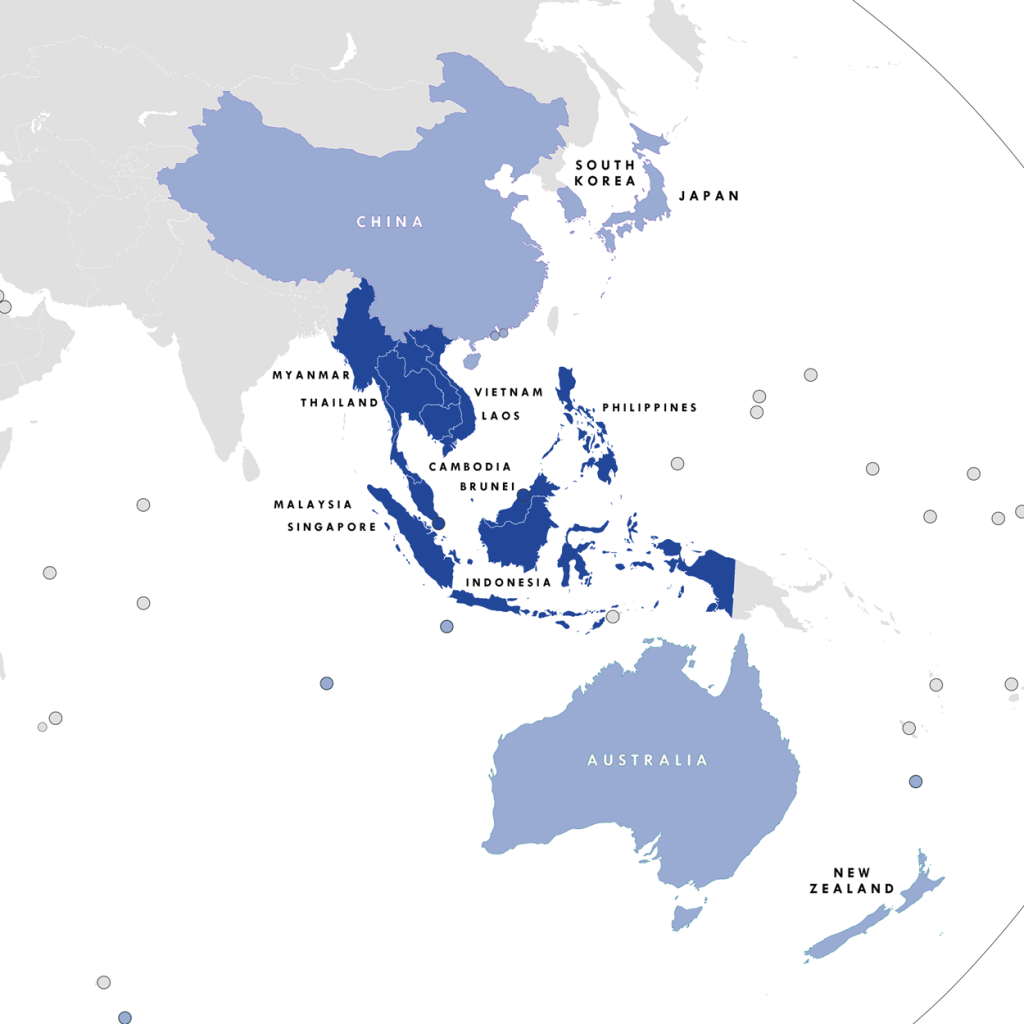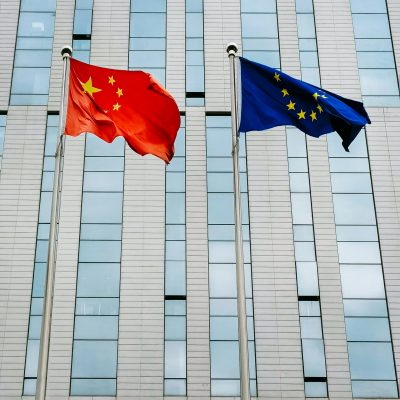RCEP: the geopolitical impact from a new wave of economic integration
By Elvire Fabry, Senior research fellow, Jacques Delors Institute, Paris

On the 15th of November 2020, the world’s largest free trade agreement was signed. While neither the European Union nor the United States are party to it, China is. The Regional Comprehensive Economic Partnership (RCEP) brings together fifteen countries from the Indo-Pacific region, including the ten members of the Association of South-East Asian Nations (ASEAN). Chinese Prime Minister Li Keqiang presented the agreement as ‘a victory for multilateralism and free trade’ of which China is the new leader.
The slowdown in international trade, caused by Donald Trump’s tariffs, has become even more pronounced during the pandemic. With the United States disengaging from multilateralism, the outgoing president also brought international cooperation to an all-time low. In this climate of mistrust, in which the World Trade Organization is looking for a second wind and protectionist measures are multiplying everywhere, Asia is becoming the center for trade-led growth. Even the escalation of retaliatory measures between China and Australia did not prevent the signing of the RCEP.
Why does this matter? The US changes its presidents but not its protectionist course, so the effect of the announcement is first of all political: RCEP marks the end of American leadership for open trade. However, its economic impact must be put into perspective. The agreement is larger in size than it is deep in substance. In other words, it is a ‘wading pool the size of an ocean’.[1] But as it enshrines China as the new gravitational center of world trade, the impact of the agreement is primarily geopolitical.
So what are the lessons for Europeans?
Much ado about nothing?
The signing of RCEP didn’t come as a surprise. Negotiations had been going on for eight years. In fact, in 2015, the United States had concluded the Trans-Pacific Partnership (TPP), which was supposed to contain the rise of China. It involved a group of twelve countries from both sides of the Pacific, but Donald Trump later withdrew his country from the agreement.
The timing of the signing, however, is a thumbing of the nose to Washington. The day after the election of the new US president, it was already expected that Joe Biden either won’t or can’t spend enough political capital to convince Congress to rejoin the agreement (now renamed the Comprehensive and Progressive Agreement for Trans-Pacific Partnership, or CPTPP in short).
In the new Cold War–this time an economic competition with China–there is bipartisan political support for US involvement. In numbers, RCEP now leads the way with its fifteen signatories which represent thirty per cent of world GDP. But it should be remembered that the share of CPTPP, which represents about fifteen per cent of world GDP, would increase to forty per cent if the US joined. And the negotiation of a transatlantic agreement, the Transatlantic Trade and Investment Partnership (TTIP) between the United States and the European Union, would even have resulted in a deal that covers nearly sixty per cent of world GDP. It should also be noted that the bilateral agreement between the EU and Japan accounts for nearly a quarter of world GDP, even though it didn’t attract much attention in Europe in 2018.
ASEAN played a key role in the negotiation of the RCEP. But the diplomacy of numbers makes China a figurehead for a model of free trade that is distinct from American protectionism. The agreement contributes to trade facilitation by removing various restrictions, but doesn’t imposes new rules for intellectual property, or social and environmental standards, as the new generation of European agreements does.
The RCEP focuses first and foremost on the gradual abolition of customs duties on more than ninety per cent of goods–less than the ninety-nine per cent of the CPTPP. Japan notably maintains numerous exceptions on strategic food products (e.g. rice, wheat, beef, pork, dairy products and sugar). Moreover, the agreement is not very ambitious on two of the major challenges of international trade in the 21st century: services and digital trade. RCEP improves the protection of personal data for e-commerce but doesn’t promote regional standards for digital technology. This could have been shaped by Chinese practices. RCEP prohibits data localization but does not prevent states from mandating the disclosure of source code, as CPTPP does. Finally, unlike the CPTPP, it does not contain social or environmental standards or restrictions for state-owned enterprises.
On the other hand, the simplification of customs procedures and in particular the unification of rules of origin with a single certificate for almost all of Asia will contribute to the development of regional value chains. RCEP will facilitate regional trade integration in the manufacturing sector at the very time when the pandemic reminds us to strengthen the resilience of value chains through diversification in the neighborhood. However, as the level of regional content required to benefit from tariff preferences is set at forty per cent, it does not create an overly protectionist barrier vis-à-vis third countries. [2] RCEP therefore promotes trade within the region but doesn’t resort to a protectionist approach towards third countries.
Regional integration will be further strengthened as the seven countries that are now part of both the CPTPP and RCEP benefit from the cumulation of trade preferences. Moreover, India’s refusal to join the two agreements further refocuses regional integration on Japan and China. The signing of the agreement will therefore also facilitate China’s strategy of region-wide offshoring of manufacturing production with low value-added, which has become less competitive as Chinese wage levels increased. Beijing now wants to focus investments on the domestic production of high value-added goods and technological innovation.
Furthermore, it is necessary to pay attention to the creation of the RCEP Secretariat.[3] It could make RCEP a regional platform for future economic and trade issues that develops regional standards on future issues (e.g. artificial intelligence, 3D printing, block chain, and digital twins); whereas ASEAN has until now always favored prior negotiations between its ten members. At a time when reform of the WTO has become inconceivable without more active plurilateral negotiations, the RCEP offers a new forum for discussion–or even the development of Chinese-style globalization without meaningful social and environmental rules.
As eighty-three per cent of trade between the signatories was already covered by prior agreements, the RCEP unifies a patchwork of earlier commitments.[4] China already had bilateral agreements with twelve of the RCEP signatories (one with ASEAN and two with Australia and New Zealand). But this is China’s first plurilateral agreement. Since South Korea had not yet joined a regional agreement and there was no agreement between Japan and South Korea, or Japan and China, the RCEP could ultimately accelerate the negotiations for a more strategic trilateral agreement between China, Japan and South Korea, which were launched in 2012.
For Europeans, this presents a number of challenges.
Europe is confronted with the pitfalls of regional integration
World trade is subject to the economic principle of gravity, which holds that geographical distance has a negative impact on trade and promotes regional integration.[5] The phenomenon is, of course, not novel. In fact, the European Union is a perfect example. We are also witnessing a strengthening of the ‘Brussels effect’, which the American Anu Bradford defined as the attractiveness of the Single Market that encourages third countries to align themselves with high European standards. In order to strengthen the resilience of European value chains through reduced reliance on one supplier, diversification of supply could also help shorten value chains which would benefit the European Union’s close neighborhood. The challenge of Global Britain outside the EU is in fact made more complex by the difficulty to withstand the gravitational pull of the EU and instead integrate into more distant markets at a time when regional integration is accelerating around the world.
Moreover, a shift of the center of gravity of the world economy toward Asia has already taken place. For the past ten years, this has compelled the European Union to sign bilateral agreements with countries in the region (South Korea, Singapore, Japan, Vietnam) and launch other negotiations (e.g. Australia, New Zealand and Indonesia).
But the strengthening of economic ties in the Indo-Pacific region and the centrality of China are undoubtedly a new challenge. Europe must anticipate China’s pull on the region’s supply. This includes not only low value-added but also high value-added goods for which Europe is still competitive but facing steady vertical integration of China’s value chains. If China were to capture the consumer appetite of an exploding middle class in the Indo-Pacific, the EU would quickly be relegated to a second-tier economic power. Europe is committed to the fight against climate change and the search for energy-efficient economic activity. But we must ensure that we have the necessary means to defend this shared preference, and avoid a degrowth scenario as the outcome of a steady decline because Europe remained on the periphery of developments in the Indo-Pacific region. The EU must continue to negotiate bilateral agreements with the countries of the region. In fact, in the absence of a bilateral agreement with ASEAN, the EU would benefit from supplementing the agreements it has with Singapore and Vietnam with a close bilateral network with other ASEAN members.
Several trade agreements that the EU has signed are not yet ratified. Before starting new negotiations, Ursula von der Leyen’s commission has made their ratification a priority. The Commission also wants to ensure compliance with existing agreements and allow companies to make better use of them. Moreover, the European public’s mistrust of international trade has led to a break from negotiations. However, by adding non-commercial regulatory objectives to European agreements (e.g. on social protection and the environment), these levers of influence become even more strategic to defend European interests. The aim is not only to increase market access for European producers in promising markets, but also to promote European standards on social protection, the environment, intellectual property, data transfers, and state aid.
Furthermore, the election of Joe Biden opens up new prospects for transatlantic cooperation. Alongside the fight against climate change, on which Biden intends to reposition the United States, the coordination of American and European positions on China is a priority for the transatlantic dialogue. The aim is not to relaunch the TTIP negotiating agenda, but to pursue the EU’s objective to strengthen multilateral rules that deal with China’s trade distortions in cooperation with other partners, such as the trilateral EU-Japan-US agreement to reduce industrial subsidies.[6] But while pushing back against the rise of China is a transparent objective for both Republicans and Democrats, it remains to be seen which alternative to weaponized tariffs Biden will use. Paradoxically, the transatlantic re-engagement of the United States could imply additional pressure for Europe to align itself with the position of the US, this time without a solidarity reflex amongst EU member states in reaction to Donald Trump’s aggressive policies.
In conclusion, the RCEP reminds Europeans that the exercise of strategic autonomy involves, first and foremost, a defense of their interests by securing access to the markets of China and the rest of the region. It also requires them to put pressure on Beijing, together with the United States and other countries, to compel China to accept more binding multilateral rules. This strategy towards China would require greater cohesion among the EU-27. Many lessons can be learnt from the operation of the European Commission’s Brexit Task Force, which succeeded in maintaining unprecedented cohesion among member states throughout the negotiations. This could help to achieve similar European unity with regard to China and at the same time facilitate constructive cooperation with the United States.
[1] ‘Child paddling pool the width of an ocean: very broad but rather shallow ‘, Alan Beattie, Trade Secrets, Financial Times, 16 November 2020.
[2] While the revision of the trilateral agreement between the United States, Canada and Mexico, USMCA (formerly NAFTA), has increased regional value content requirements in the automobile sector to seventy-five per cent.
[3] Deborah Elms, “RCEP – Separating fact from friction”, Trade Talks 143, PIIE, 18 November 2020.
[4] Estimate by Soumaya Keynes, ibid.
[5] ‘Brexit: Breaking the Laws of Gravity?’ Elvire Fabry & Andreas Veskoukis, Jacques Delors Institute, 13 October 2020.
[6] ‘Industrial subsidies are at the heart of the trade war’, Elvire Fabry, Jacques Delors Institute, 21 January 2020.
Translation: Nicolas Köhler-Suzuki




